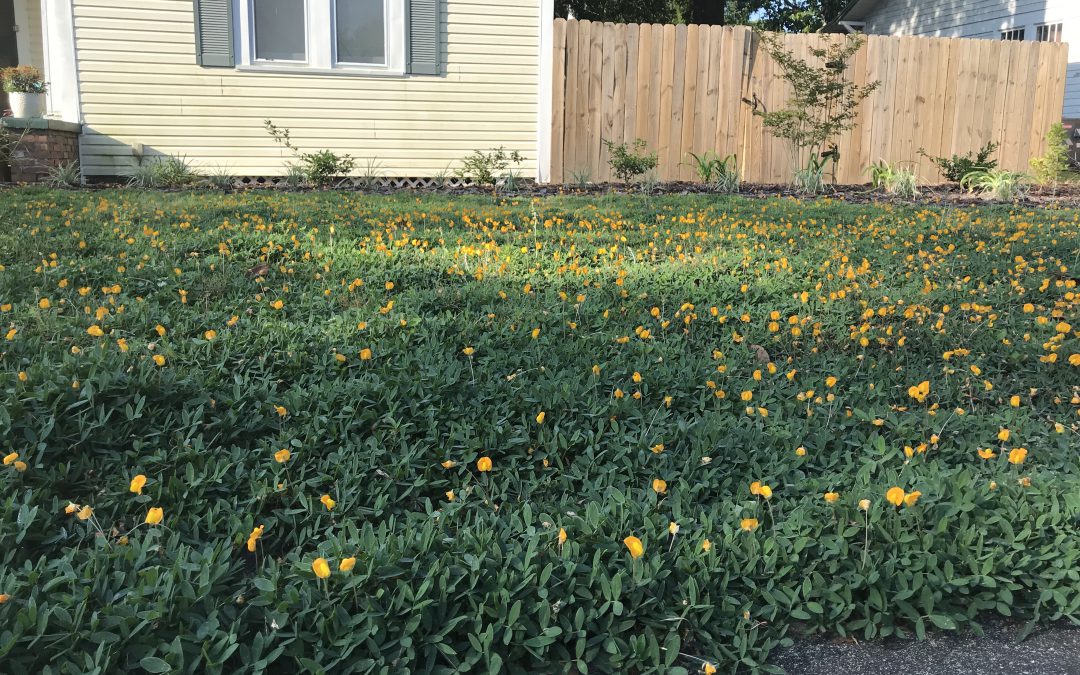
by Matt Lollar | May 5, 2022
Turf lawns provide an excellent groundcover that hold soil in place, filter pollutants, and are beautiful. However, turfgrass may not be your first groundcover choice, due to heavy shade, landscape layout, or just personal preference. In that case, there are a lot of alternative groundcovers on the market. To help determine what groundcovers do best under certain conditions and to provide information on lawncare and groundcover maintenance, this month’s Gardening in the Panhandle LIVE! was all about groundcovers.
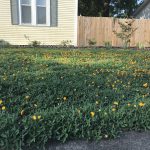
‘Needlepoint’ Perennial Peanut in a yard. Photo Credit: Daniel Leonard, University of Florida/IFAS Extension – Calhoun County
Turfgrass/Groundcover Selection
The University of Florida/IFAS has a long list of publications on alternatives to turfgrass. The comprehensive list can be found at Ask IFAS: Groundcovers.
One of the groundcovers that does well in full sun and has beautiful yellow flowers is perennial peanut. More information on perennial peanut can be found in the publication “Guide to Using Rhizomal Perennial Peanut in the Urban Landscape”.
Groundcover options for the shade include Algerian ivy, Asiatic jasmine, and mondo grass. Read more about these and other shade friendly species at “Gardening Solutions: Groundcovers for the Shade”.
Frogfruit can tolerate full sun and partial shade.
You could also create a wildflower meadow in a sunny spot. More wildflower information is available at Ask IFAS: Performance of Native Florida Plants Under North Florida Conditions.
White clover is a groundcover that may be best suited in a mix with other groundcover species. The publication “White Clover” provides some excellent information on growing this plant.
A number of factors come into play when you are choosing a turfgrass species. Some species are more tolerant of shade than others and maintenance levels are species and variety specific. The “Choosing Grass for Your Lawn” webpages can help answer some common questions. For additional information on turfgrass species a list of EDIS publications and other UF/IFAS websites is available at Ask IFAS: Your Florida Lawn. (Note: Buffalograss is not recommended for Florida.)
Overseeding is not a recommended practice for home lawns, but information is available at the webpage “Overseed Florida Lawns for Winter Color”.
Management of Turf and Groundcovers
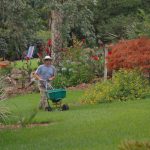
Fertilizing a lawn. Photo Credit: University of Florida
Turfgrass requires the right amount of care. To help maintain a good looking yard, follow the management practices in the publication “Homeowner Best Management Practices for the Home Lawn”.
A soil sample is a good place to start to determine the root of the issues you may have in your lawn. Follow these simple steps to collect and submit a sample for accurate analysis.
Weed management can be difficult in turf and other groundcovers. Cultural, mechanical, and chemical controls can help keep weeds under control. The “Weed Management Guide for Florida Lawns” provides control options for the majority of weeds you’ll encounter in your lawn. More information on weed control in turf alternatives can be found in the publication “Improving Weed Control in Landscape Beds”.
Virginia buttonweed is a common weed that is often difficult to control. Doveweed can also be difficult to control.
The publication “Adopting a Florida Friendly Landscape” outlines the nine principals to help you design, install, and maintain a landscape that will thrive in our climate.
Fertilizer is required to maintain a healthy lawn. A list of lawn fertilization publications and links can be found at Ask IFAS: Lawn Fertilizer.
Lawns in the southeast are susceptible to a number of different diseases mostly thanks to our hot and humid weather. But there are some preventative and curative practices you can implement to help keep disease under control. The “Turfgrass Disease Management” publication answers a lot of questions about disease control.
Past episodes of Gardening in the Panhandle LIVE can be found on our YouTube playlist.
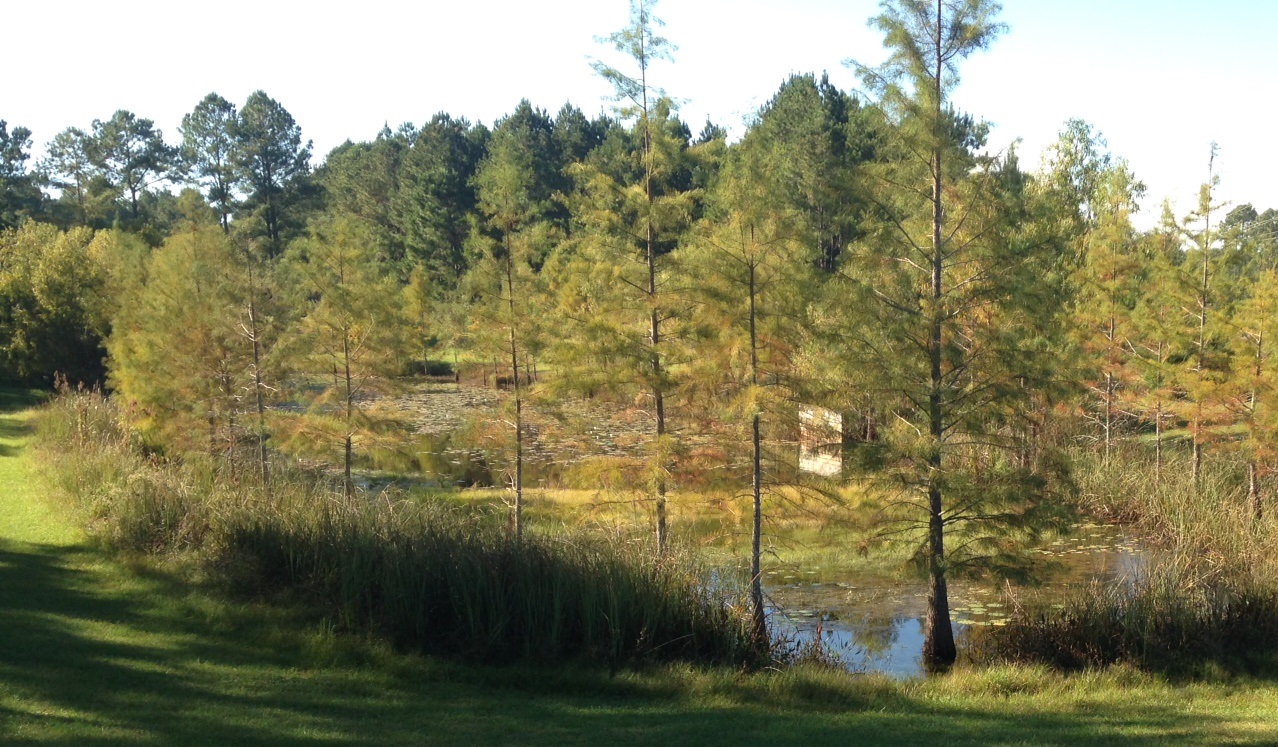
by Ashley Stonecipher | Apr 20, 2022
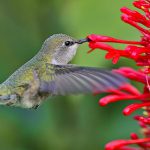
A hummingbird gathering nectar from a firespike (Odontonema strictum) flower. Photo Credit: Knolllandscapindesign.com
Do you enjoy watching a variety of birds and butterflies in your landscape? Have you ever watched squirrels get into the birdfeeder? Children may learn about wildlife by watching through a window. Food, water, cover, and space are four essential elements that will create the best habitat for wildlife. Food could be as simple as adding feeders to attract birds to your yard but having a habitat that sustains them is important. Florida wildlife and Florida native plants evolved together and are often interdependent. It is a must to understand what sustains the species you are wanting to attract to your area. Different species prefer different food/plants. Insects also provide birds a food source for their young.
Water can be bird baths, man-made ponds, and natural bodies of water such as streams, lakes, ponds on your property. When relying on a bird bath for your water supply make sure the water is fresh and clean. Shallow water (1-1.5 inches) is better than deep (over 3 inches). Birds like sloping sides and a textured surface; they prefer to walk into water rather than dive in headfirst. Place the bath 5 to 10 feet from a protective cover like shrubs or trees. This needs to be close enough for the birds to be able to reach safety if there is danger from predators. A small outpost for birds to land on near the bath can help them check for predators before heading to the bath.
Cover will provide a place to raise young and should have vertical layers for animals to use for safety, shelter, and nests. Examples of cover that could be added to the landscape are snags that give food for woodpeckers and nesting perches. Or build your own nesting boxes that are species specific for owls, bees, and bats. All bats eat insects and substantially reduce the number of nocturnal insects in a neighborhood.
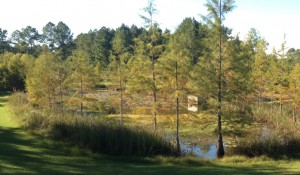
The permanently wet detention pond lined with cypress trees and sawgrass also provides habitat for fish, birds, and reptiles. Photo Credit: Carrie Stevenson, University of Florida/IFAS Extension – Escambia County
Lastly it is important to think of your space. Create large patches of good habitat that span several landscapes or consider working with your neighbors to link the backyard habitats and create a larger area. It is all about the “Right Plant, Right Place” concept and understanding the area you are working with and the possibilities. When you go into the last step of planting and attracting wildlife have a plan and know what you would like to attract. Do your research on what you will need for that wildlife and use your resources, ask your local extension agent for ideas and suggestions!
Many plants in our native landscape provide much of what attracts wildlife and provides them with at least one of the four essential elements. The article “Planting for Wildlife Habitat!” will give you some ideas of plants and trees that do well in the North Florida area and will help to attract the wildlife you desire!
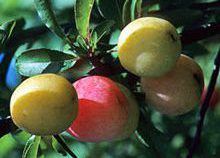
by Ashley Stonecipher | Apr 14, 2022
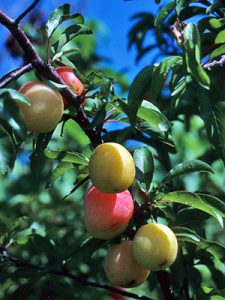
Humans and wildlife find Chickasaw plums delicious. Photo credit: University of Florida/IFAS
There are many trees that can be a great addition to your space that will provide one of the four essential elements food, water, cover, and space. Persimmon thrives in a wide variety of conditions from wet or sandy soil to lowlands or uplands. Deer actively seek out persimmon trees, eating every fruit that is within reach as well as leaves and twigs in the fall and winter. Other wildlife that enjoys the persimmon trees are squirrel, fox, bear, coyote, raccoon, opossum, and various birds including wild turkey. The nectar from flowers provides a significant food resource for pollinator species like bees. These trees are either male or female and at least 3 should be planted together to ensure pollination. Live Oak is a solid tree that many people in this area said survived Hurricane Michael. It provides acorns for food and deep shade. Black Cherry is a host plant for Red-Spotted purple and Eastern Tiger Swallowtail. Bitter fruit matures during the summer to fall and is used for jams, jellies, or liqueurs. Fruits are highly prized by birds and other wildlife. Wild cherry cough syrup is made from the reddish-brown, fragrant and bitter inner bark. Yaupon Holly is another tree that birds and wildlife feed on the berries throughout the winter when food is scarce. Leaves have the highest caffeine content of any other plant native to North America. Some other trees to consider are Basswood, Red Cedar, Florida Hop tree, Elderberry, Slippery Elm, Sassafras, Chickasaw Plums, and the Toothache Tree.
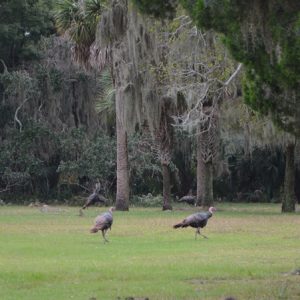
While yard work is important to maintain an attractive lawn, if done successfully, the resident can spend quality time in other pursuits like watching the wildlife from the front porch.
There are many plants that for the longest time I thought were only a nuisance to the everyday gardener, but I truly learned the phrase “Right Plant, Right Place” with these next few plants that I am going to mention. Smilax is a vine with thorns that is nearly impossible to get rid of and gets into our shrubs and landscape. But in the right place smilax provides shelter and food for wildlife. It has a blue-black berry in the spring and provides medicine, food, and dyes for humans. There are 2 species of smilax that are only found in the panhandle. Dog Fennel is native to fields, woodland edges, and roadsides and can be used as an insecticide and antifungal. It has feather like leaves that are very aromatic. Blackberry can grow wild and it is an all-around amazing plant for vitamins. It’s fruit can help fight cancer and decrease cardiovascular disease. Leaves and bark are useful medicinally and leaves can be used as a tea. The last plant I must mention is the Beauty Berry. It is known for its late fall bright purple fruits called drupes, not berries. This plant attracts birds for food in the fall time in North Florida. The drupes can also be used for jams and jellies. Other plants that are great for attracting wildlife are Spiderwort, Dewberry, and Spanish Needle.
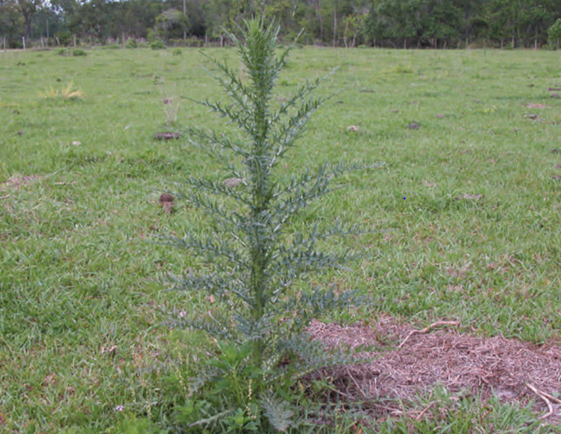
by Ray Bodrey | Apr 7, 2022
The thistle has long been an enemy of ranchers, county roadside maintenance crews and homeowners. Often difficult to control, it causes both headaches for producers, in reduction of grazing for livestock as well as being an eyesore for gardening enthusiasts. There are nine different species of thistle in Florida. Most of these are closely related, therefore the control protocols are the same. Only one species is a perennial, and all others are biennial. A biennial plant grows from seed in one year and produces seed for the next.
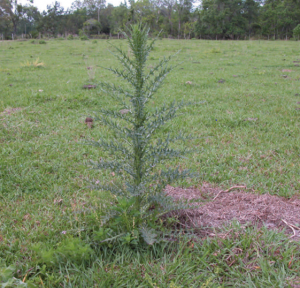
Thistle that has begun to bolt. Photo Credit: Dr. Jason Ferrell, University of Florida/IFAS Agronomy Department-Weed Science.
It’s important to understand the biology of the thistle in regards of seeking control of this fast spreading weed. This plant will grow a taproot and a cluster of leaves in the first year. This is known as the rosette stage. In the second year, a stalk will appear from the center of the rosette. This is called “bolting”. A seed head will form once the bolting stage is complete. Amazingly, one thistle plant can amass 4,000 seeds. The plant faces its demise after releasing the seeds. The rosette growth stage is mostly during the winter months with bolting occurring from January to July. This is important to note when battling this persistent weed.
As for control, preventing the thistle from producing seed is the most important management measure. Otherwise, little can be done to stop the outbreak of the weed. For homeowners, manually removing the rosette and tap root by hand is effective with small stands. Be careful and wear protective coverings on your hands and arms. Keep in mind, the plant will come back if the tap root is not fully removed.
Other physical control methods, like mowing, have mixed results. This can be effective if mowing occurs after the bolting stage has occurred, but before the seed head forms. However, this is tricky, as thistle plants often do not bloom at the same time.
Thistles in the rosette stage are very susceptible to herbicides. Although, applying a herbicide after the seed head has formed has little effect on control. Herbicides containing 2,4-D are very effective for landscapes. Timing of application is critical. The key to controlling this weed is by scouting and identifying stands as early as possible.
If you’re a beekeeper, there is an upside to this weed. Delicious honey can be made from the thistle bloom.
For more information on thistle, please contact your local county extension office.
Supporting information for this article can be found in the UF/IFAS EDIS Publication, “Thistle Control in Pastures” by Dr. Brent Sellers and Dr. Jason Ferrell.
UF/IFAS Extension is an Equal Opportunity Institution.

by Larry Williams | Mar 24, 2022
Calibrating or determining the rate of water your sprinkler system applies is an easy job.
Here’s how to do it:
- Obtain 5 to 10 straight-sided empty cans such as tuna fish or soup cans.
- Place the containers randomly within the irrigated area so that they catch the water when the irrigation system is running. This needs to be done for each irrigation zone, separately.
- Turn the water on for 15 minutes.
- Use a ruler to measure the depth of water in each can. The more exact your measurement, the better your calibration will be. Measurements to the nearest 1/8 inch are adequate.
- Determine the average depth of water collected in the cans (add up the depths of water measured in each can and then divide by the number of cans).
- To determine the irrigation rate in inches per hour, multiply the average depth of water times four. For example, if you collected an average of ¼ inch of water in the cans as a result of letting the irrigation run for 15 minutes, the irrigation zone would need to run for 30 minutes to apply ½ inch of water, or 45 minutes to apply ¾ inch of water, etc.
It’s best to do this calibration exercise during the same time of day the system normally runs so that water pressures are similar.
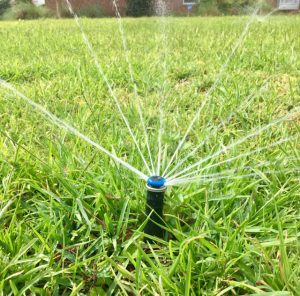
Irrigating lawn. Photo credit: Larry Williams
Here’s why calibrating your system is important.
When a timer/controller is set to come on frequently for short intervals of time (every other day for 20 minutes for example), the result will be a shallow, weak root system and a lawn that becomes dependent on its shallow roots being watered frequently. Also, watering frequently benefits certain weeds such as dollarweed and nutsedge while weakening the lawn.
To develop a deep, strong root system and a lawn that will go through hot, dry weather in better shape without requiring water as often, switch the automatic timer to manual.
Watering a lawn on an as needed basis is the best way to water correctly and develop a deep-rooted lawn. This is the reason for calibrating your irrigation system. You should apply ½ to ¾ inch of water to the lawn only when the grass indicates that water is needed. When the grass needs water, the leaf blades fold along the midrib (like a book closing). Also, footprints or tire tracks remain in the lawn long after being made. And, the lawn turns grayish in spots, indicating it needs water.
When 30 to 40 percent of the lawn shows these signs of water need, turn the irrigation system on and let it run long enough to apply ½ to ¾ inch of water. Don’t water again until the lawn begins to show these signs of water need. Don’t water when adequate rain has occurred.
The best time to observe these signs of water need is during the evening when the grass is not in full sun or under heat stress. It’s best to irrigate during early morning hours to prevent lawn diseases and to minimize water lose due to wind and evaporation. The lawn grass is a great indicator for when most other established plants in a landscape need water as well.













